If you've been keeping up with PCSTATS you'll know that in the Asus EN9600GT videocard review we
mentioned that there are other, more affordable graphics cards better suited to
playing movies
on a HTPC. As luck would have it, one of them magically appeared
in the PCSTATS labs this week.
ASUS' EN9400GT is a half-height Geforce 9400GT videocard
specifically made for those cramped Home Theatre PC situations that are a pain
come upgrade time. It packs in VGA, DVI and most importantly an HDMI output
right on board, and best of all, for older PCI Express x16 equipped PCs it does
the High Definition video acceleration itself! Ever try to do HD
decoding on an older PC? Take our word for it, without an HD accelerator it
ain't pretty. ASUS' EN9400GT-1GB is HDCP complaint, meaning it can output both
audio and video from Blu-ray discs and other protected sources at full
quality, to HDCP compliant displays. Not sure what HDCP is or means? Read
this PCSTATS guide to get the low
down.
At the heart of the ASUS EN9400GT is nVidia's
legacy G96 GPU, a budget-oriented graphics processor that's been
around the block a few times. It's used in the Geforce
9500 GT, and derived from the G92 GPU that formed the basis of the popular Geforce
9600GT. However, this stripped down GPU has 16 stream processors, a core clock of
550MHz, and on the Asus EN9600GT comes with 1GB of GDDR3 memory
paced at 800MHz. We'll see if that extra memory helps this videocard at all
in the gaming benchmarks later on, but don't hold your breath...
While nVidia might like say that the Geforce 9400GT "has a 2x performance increase over the comparable 8 series
graphics cards allowing you to play the latest PC games", the reality is it's not capable of handling most
modern 3D games at anything near 60FPS. You may be able to game in a few
less image intensive titles at 1024x768 resolution, but mostly the ASUS
EN9400GT videocard is good for another reason. For starters, compared to most
integrated graphics chipsets it offers a slight performance edge, and I do mean slight,
but mostly it's the little HDMI connector on the back of the
half-height, $50 ASUS EN9400GT card that makes it particularly special.
HDMI stands for High Definition
Multimedia Interface, and it's the de facto standard for sending HD video
and digital audio signals to today's generation of LCD flat screen TV's,
like this sweet 52" baby from Samsung called the A850. Pop a graphics card with
onboard HDMI into your PC and you can essentially turn that computer into a
media center; good for playing back downloaded movies, home videos, or even just
the Windows desktop onto a bigger screen the family (or office) can comfortably
gather around.
The Asus EN9400GT runs about $50 CDN ($46 USD £28 GBP), so it's an affordable way to
get HD output into a compact PC that can't accept full size videocards, or that
lack the power and outputs to be effective home theatre system. As you'll see in
the benchmarks, mainstream graphics cards slay the Geforce 9400GT when it comes
to 3D gaming performance, but for those of you that predominantly just work in
email, word or surf the web it's more than sufficient.
Simple desktop applications don't require fancy gaming videocards. If you
don't game but are fed up with perhaps Windows Vista's Aeroglass interface
slowing down the computer's integrated graphics chipset, or worse yet find
it unable to support a widescreen 24" LCD at its native resolution, an
inexpensive videocard like this might just fit the bill. For the
budget-constrained gamers, PCSTATS will be tossing the full might of our
videocard benchmark suite at the ASUS EN9400GT so you can see just how it
compares to similarly classed videocards like the Radeon HD 4550 and 4350.
 |
|
ASUS EN9400GT
Videocard |
|
|
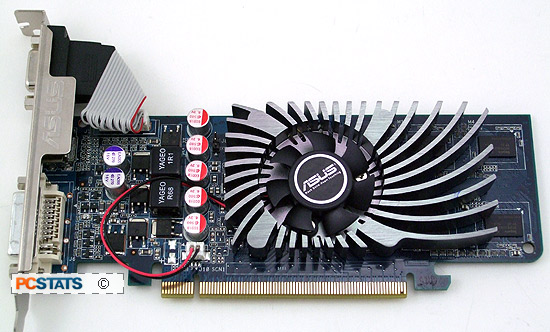
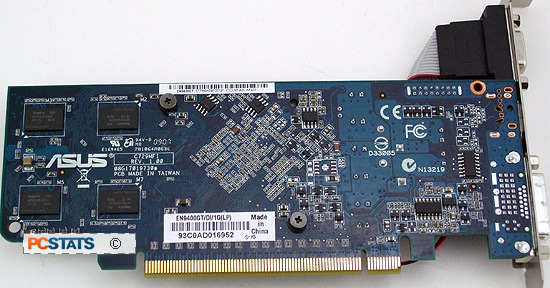
|
| Includes: |
|
User
Manual, Driver CD, Utilities CD, low-profile I/O shield,
SP/DIF jumper cable |
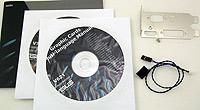 | | |
Included in the box with the Asus EN9400GT is a driver
CD, utility CD and a half-height I/O panel. There's also an included S/PDIF
pass-through cable, and manual. Not a whole lot, but everything you need to get
the PCI Express x16 videocard installed and running.
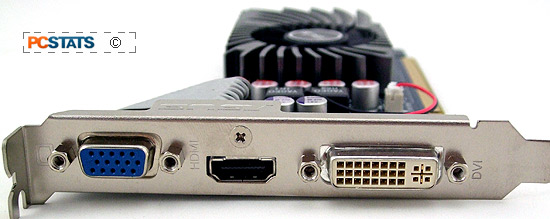
Around back at the I/O panel we
find VGA, HDMI and DVI video outputs can be used independently, or in
dual-output mode with either the DVI or HDMI being used in conjunction with the
DVI output. The dual-link DVI output can output resolutions as high as 2560 x
1600, while the HDMI output can do 1920 x 1080. The analog VGA port supports
resolutions up to 2048x1536 pixels.
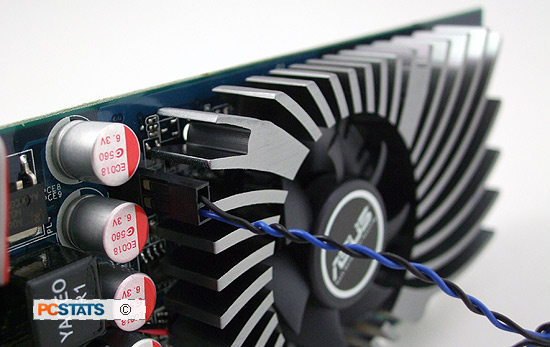
The HDMI port is HDCP compliant naturally,
and can carry both audio and video from your PC out to any HDMI-compatible HD
TV. To get audio off of the HDMI output, an S/PDIF pass-through cable must be
connected from the ASUS EN9400GT videocard to the SP/DIF connector on the
motherboard. Asus include the small jumper cable with the card, and it's not too
difficult to set up. If you've thrown away your motherboard manual and the board
itself isn't labeled (most motherboards indicate the 4-pin SPDIF connector with
a little silk-screened label next to the header), you can always download the
motherboard manual from the manufacturers website. This is one of the great
aspects about Radeon-based videocards, they have a built-in audio codec
which eliminates the need for any cables feeding to the videocard.
Half-Height
Videocard
How does a full size videocard fit into a book-size PC
chassis? The answer is simple, it doesn't unless you have a half-height
videocard. ASUS have thoughtfully supplied a half-height metal I/O bracket along
with the EN9400GT videocard so you can swap out the brackets yourself. The
analog VGA port is mounted via flexible cable to the videocard PCB, and the
half-height bracket is two-slots wide to accommodate it.
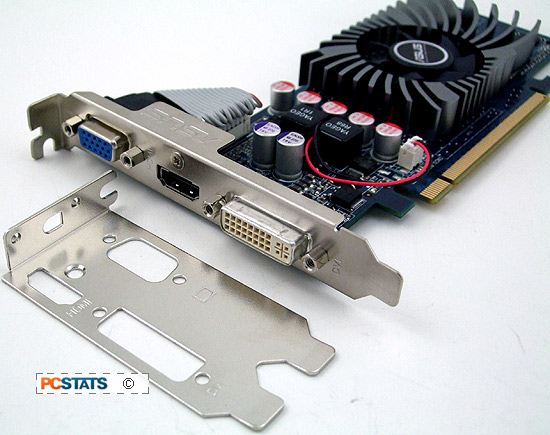
The Analog VGA connector is attached to the videocard
with flexible cable because it will be repositioned above the HDMI jack when the
half-height I/O bracket is used. In most computers there should be sufficient
space, but you might want to double check that there is an additional slot free
next the PCI Express x16. The downside to this approach is clearly that you lose
an entire slot in the computer, which is a lot given that most slim PCs usually
only have three or four expansion slots at the most.

